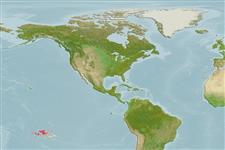Issue
Type locality: Rangiroa, Tuamotu Archipelago.
Environment: milieu / climate zone / depth range / distribution range
Ecologia
marinhas demersal; intervalo de profundidade 120 - 250 m (Ref. 5222). Tropical; 10°S - 24°S, 156°W - 135°W (Ref. 5222)
Eastern Central Pacific: known only from the French Polynesia, Pitcairn Group, and Rapa.
Tamanho / Peso / Idade
Maturity: Lm ? range ? - ? cm
Max length : 66.0 cm SL macho/indeterminado; (Ref. 5222)
Espinhos dorsais (total) : 11; Raios dorsais moles (total) : 15; Espinhos anais: 3; Raios anais moles: 8. Distinguished by the following characteristics: pale yellowish brown body color; irregular coarse reticulum of dark brown on body and rear part of head; fins unmarked; body depth contained 2.7-2.9 times in SL; head length 2.2-2.4 times in SL; convex interorbital area; subangular preopercle, 3-4 distinctly enlarged serrae at the angle; straight or nearly straight upper edge of operculum; anterior nostrils smaller than posterior nostrils; maxilla reaches almost to or slightly past vertical at rear edge of eye; 2 rows of teeth on midlateral part of lower jaw, inner teeth larger; well developed canine teeth at front of jaws (Ref. 89707).
Inhabits the outer slope of coral reefs. Fourmanoir (1971, Ref. 6828) found ophichthid eels, Leiuranus phoenixensis, in the stomachs of his type specimens. May be of some importance to artisanal fisheries and it is rarely caught because of its preference for deep water.
Life cycle and mating behavior
Maturities | Reprodução | Spawnings | Egg(s) | Fecundities | Larvas
Heemstra, P.C. and J.E. Randall, 1993. FAO Species Catalogue. Vol. 16. Groupers of the world (family Serranidae, subfamily Epinephelinae). An annotated and illustrated catalogue of the grouper, rockcod, hind, coral grouper and lyretail species known to date. Rome: FAO. FAO Fish. Synop. 125(16):382 p. (Ref. 5222)
Categoria na Lista Vermelha da IUCN (Ref. 130435)
Ameaça para o homem
Harmless
Utilização humana
Pescarias: pouco comercial
Ferramentas
Relatórios especiais
Descarregue XML
Fontes da internet
Estimates based on models
Preferred temperature (Ref.
123201): 5.7 - 5.7, mean 5.7 °C (based on 2 cells).
Phylogenetic diversity index (Ref.
82804): PD
50 = 0.5000 [Uniqueness, from 0.5 = low to 2.0 = high].
Bayesian length-weight: a=0.01175 (0.00571 - 0.02419), b=3.04 (2.88 - 3.20), in cm total length, based on LWR estimates for this Genus-body shape (Ref.
93245).
Nível Trófico (Ref.
69278): 3.9 ±0.6 se; based on size and trophs of closest relatives
Resiliência (Ref.
120179): Baixo, tempo mínimo de duplicação da população 4,5 - 14 anos (Preliminary K or Fecundity.).
Fishing Vulnerability (Ref.
59153): Moderate to high vulnerability (52 of 100).
